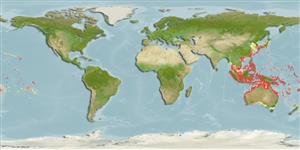Common names from other countries
Environment: milieu / climate zone / depth range / distribution range
Ekologi
marina revassocierade; djupintervall 2 - 55 m (Ref. 30874). Tropical; 22°C - 28°C; 43°N - 40°S, 95°E - 130°W (Ref. 55292)
Pacific Ocean: Cocos-Keeling Islands and Western Australia (Ref. 27362) in the eastern Indian Ocean to the Marquesas and Oeno (Pitcairn group), north to southern Japan and southern Korea, south to Lord Howe Island, northern New Zealand, and the Austral Islands. Replaced by the very similar Pterois miles from the Red Sea to Sumatra.
Length at first maturity / Size / Vikt / Age
Maturity: Lm ?, range 16 - ? cm
Max length : 45.7 cm TL hane/ej könsbestämd; (Ref. 118189); publicerad maxvikt: 1.4 kg (Ref. 118189); rapporterad maxålder: 10 år (Ref. 72479)
Taggstrålar i ryggfenan (totalt) : 13; Mjukstrålar i ryggfenan (totalt) : 9 - 12; Taggstrålar i analfenan: 3; Mjukstrålar i analfenan: 6 - 8. Scales cycloid (Ref. 37816). Variable in color, usually in relation to habitat. Coastal species generally darker, sometimes almost black in estuaries. Often with large tentacles above eyes (Ref. 48635).
Inhabit lagoon and seaward reefs from turbid inshore areas to depths of 50 m. Often solitary, they hide in unexposed places at daytime often with head down and practically immobile. Pelagic juveniles expatriate over great distances and the reason for their broad geographical range (Ref. 48635). Hunt small fishes, shrimps, and crabs at night, using its widespread pectorals trapping prey into a corner, stunning it and then swallowing it in one sweep. Dorsal spines are venomous; the sting can be treated by heating the afflicted part and application of corticoids (Ref. 5503). A popular table fish.
Life cycle and mating behavior
Maturities | Reproduktion | Spawnings | Egg(s) | Fecundities | Larver
Myers, R.F., 1991. Micronesian reef fishes. Second Ed. Coral Graphics, Barrigada, Guam. 298 p. (Ref. 1602)
IUCN Red List Status (Ref. 130435)
CITES (Ref. 128078)
Not Evaluated
Human uses
Fiskeri: kommersiell; Akvarium: Kommersiell
Verktyg
Special reports
Download XML
Internet-källor
Estimates based on models
Preferred temperature (Ref.
115969): 22.4 - 29, mean 27.9 (based on 756 cells).
Phylogenetic diversity index (Ref.
82804): PD
50 = 0.5005 [Uniqueness, from 0.5 = low to 2.0 = high].
Bayesian length-weight: a=0.00813 (0.00632 - 0.01046), b=3.08 (3.01 - 3.15), in cm Total Length, based on LWR estimates for this species (Ref.
93245).
Trofisk nivå (Ref.
69278): 4.4 ±0.4 se; based on diet studies.
Resiliens (Ref.
120179): Hög, lägsta populationsfördubblingstid mindre än 15 månader (Preliminary K or Fecundity.).
Fishing Vulnerability (Ref.
59153): Low to moderate vulnerability (34 of 100).
